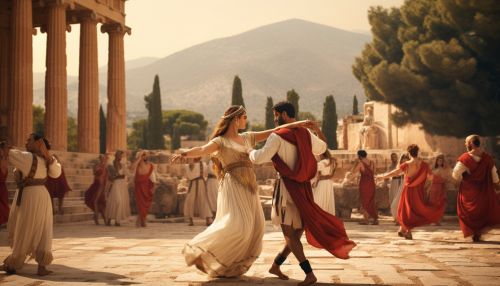Ancient Greek Dance
Origins and History
Ancient Greek dance has its roots in the early civilization of Greece, where it played a significant role in society. The earliest evidence of Greek dance dates back to the Bronze Age, as depicted in the frescoes of the Minoan civilization on the island of Crete. These frescoes portray scenes of acrobatic leaps, which are believed to be a form of dance.


Dance was an integral part of Greek culture, permeating various aspects of life, from religious rituals and ceremonies, to athletic games, theatrical performances, and social gatherings. The Greeks believed that dance was a gift from the gods and considered it a form of communication with the divine.
Types of Dance
There were numerous types of dances in ancient Greece, each with its own style, rhythm, and purpose. Some of the most notable include the Pyrrhic, a fast-paced, warlike dance performed by men; the Gymnopedia, a dance performed by naked youths during athletic events; and the Cordax, a comedic, often obscene dance performed at the end of comedic plays.
Role in Religion and Ritual
In ancient Greece, dance was deeply intertwined with religion and was often used in rituals and ceremonies dedicated to the gods. The Dionysian Mysteries, for example, involved wild, ecstatic dances in honor of Dionysus, the god of wine and ecstasy. Similarly, the Dance of the Graces was performed to honor the Graces, goddesses of charm, beauty, and creativity.
Dance and Theatre
Dance played a crucial role in ancient Greek theatre. The chorus, a group of performers who commented on the action of the play, often communicated through dance. In tragedies, the chorus performed the Emmeleia, a solemn, dignified dance. In comedies, they performed the Sikinnis, a lively, fast-paced dance.
Social and Cultural Significance
Dance was not only a form of entertainment in ancient Greece, but also a means of social and cultural expression. It was used to celebrate victories, commemorate events, and express communal emotions. Dance competitions were common, and excellence in dance was highly valued.
Legacy
The influence of ancient Greek dance can be seen in various forms of dance today, from ballet to contemporary dance. The Greeks' emphasis on rhythm, movement, and the expression of emotion through dance has had a lasting impact on the world of dance.
